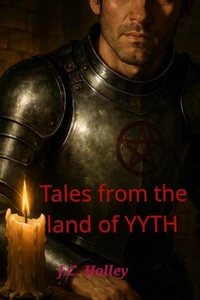In the lands of YYTH, the rise of the Crimson Pentacle marked an era of unprecedented order and dominion. Knights clad in Hastorn-forged armor became living instruments of both martial and magical power. Each cuirass bore a pentacle sigil etched over the heart, imbued with enchantments capable of repelling blade, bolt, and spell alike. Their combined skill and mystical might rendered them nearly invincible on the battlefield, and where they marched, kingdoms fell, borders were redrawn, and obedience-or terror-was enforced with absolute precision.
The racial landscape of the world was irrevocably altered by these campaigns. Goblins, orcs, and minotaurs faced near-total eradication; survivors were driven into remote, forbidden wilds, hiding from the knights' relentless pursuit. Elves and dwarves were spared, but only under strict treaty. Elves were forbidden to settle far from their sacred forests, bound by wards and oversight to ensure isolation, while dwarves were confined to mountainous strongholds and mines, tolerated solely for their craftsmanship and fortitude.
Both peoples lived under the constant shadow of surveillance, their freedom tightly circumscribed. Tales from Steel City brings forth a dynamic landscape of short stories that range in style and scope that follow clerics, wizards, tinkers and rogues through an interconnected setting. The world keeps growing with each story and characters may make appearances through out.
In the lands of YYTH, the rise of the Crimson Pentacle marked an era of unprecedented order and dominion. Knights clad in Hastorn-forged armor became living instruments of both martial and magical power. Each cuirass bore a pentacle sigil etched over the heart, imbued with enchantments capable of repelling blade, bolt, and spell alike. Their combined skill and mystical might rendered them nearly invincible on the battlefield, and where they marched, kingdoms fell, borders were redrawn, and obedience-or terror-was enforced with absolute precision.
The racial landscape of the world was irrevocably altered by these campaigns. Goblins, orcs, and minotaurs faced near-total eradication; survivors were driven into remote, forbidden wilds, hiding from the knights' relentless pursuit. Elves and dwarves were spared, but only under strict treaty. Elves were forbidden to settle far from their sacred forests, bound by wards and oversight to ensure isolation, while dwarves were confined to mountainous strongholds and mines, tolerated solely for their craftsmanship and fortitude.
Both peoples lived under the constant shadow of surveillance, their freedom tightly circumscribed. Tales from Steel City brings forth a dynamic landscape of short stories that range in style and scope that follow clerics, wizards, tinkers and rogues through an interconnected setting. The world keeps growing with each story and characters may make appearances through out.

 , qui est-ce ?
, qui est-ce ?